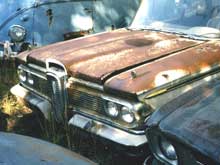I’ve always had a fondness for the Edsel. As a car-consumed young person, I eagerly followed the gestation of Ford’s “E-car” in the press and broadcast news reports. When the car was unveiled on September 4, 1957, just five days before my 13th birthday, I was elated. The car was
dramatic in a way that hadn’t been seen since, perhaps, the Step-down Hudson of 1948. I was not, however, enamored of the name, for unlike most Americans I was fully aware of Edsel Ford and his automotive legacy – and shared the Ford family view that attaching his name to an automobile accrued some measure of risk. Little did we know, however, that it would become a synonym for failure.
The 1958 Edsel was
bold in its styling, which people either liked or hated (I liked it; still do). I was also bold in its market approach: two niches in the Ford catalog, one between Mercury and Lincoln and another between Ford and Mercury. There were two sizes and four series, from the top
Citation and
Corsair on a 124-inch wheelbase,
Pacer and
Ranger on Ford’s 118 and 116-inch wheelbases. Exclusive Edsel features included
“Teletouch” push button transmission control on the steering wheel, a novel
heating and ventilating system, and a
dashboard-mounted
tachometer and compass. Engines were designated not by their horsepower or displacement but by their
torque figures.
Any one of these innovations might have been risky; together they were a disaster. The public stayed away in droves, and the make that was supposed to plug alleged “holes” in the Ford catalog sold barely 63,000 cars, less than half Mercury’s total and one fifth that of Buick or one third of Pontiac, and it was supposed to compete with both of them.
For 1959, retrenchment was the word, one wheelbase and two series of Ford-based cars,
Corsair and Ranger. The “horsecollar” grille became an ornament on a Ford nose, though the rear retained its
boomerang fin theme. Sales fell by a third, in a generally improving market.
By the 1960 model year it was really over. The car became a
Ford clone with a
grille resembling the previous year’s Pontiac.
Inside and out it was plain that it was a Ford, with
Ford engines – including a six introduced for 1959. Conventional wisdom says the
convertible, with 76 built, was the rarest, but acutally the
nine-passenger Villager
wagon, at 59 units, was the champion underachiever.
On November 19, 1959, the Edsel was given a lethal injection and the last car rolled off the line. In retrospect it seems like a foolhardy venture, but it must have seemed like a good idea at the time. The Edsel is sometimes described as poorly engineered, but aside from features, like Teletouch, not fully developed it was no worse than any other 1958 Ford product.
Were I to indulge in an Edsel, which one would I buy? I’d probably go whole hog with a
’58 Citation convertible. It’s unlikely it would be a prizewinner; it certainly wouldn’t be a
trailer queen.

